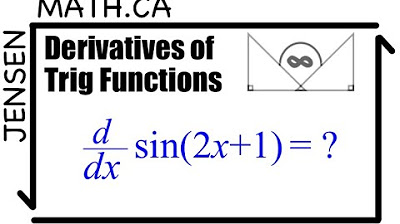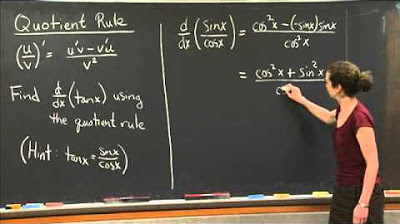Quotient Rule For Derivatives
TLDRThe video script provides a comprehensive guide on using the quotient rule to find derivatives of functions, particularly those in fractional form. It explains the quotient rule formula, demonstrates its application through various examples, and emphasizes the importance of simplifying the results when possible. The examples cover a range of scenarios, from basic polynomial functions to trigonometric functions, and even includes a proof of the derivative of the tangent function being secant squared.
Takeaways
- 📚 The derivative of a function in the form of a fraction can be found using the quotient rule.
- 🔢 The formula for the quotient rule is: (g * f' - f * g') / g^2, where f is the numerator and g is the denominator.
- 🌟 Example 1: The derivative of (7x + 4) / (x^2 + 5) is found by identifying f = 7x + 4 and g = x^2 + 5, then calculating f' and g'.
- 📈 For the first example, f' is 7 and g' is 2x, leading to a simplified derivative expression of (7x^2 - 7x^2 - 8x) / (x^2 + 5^2).
- 🌟 Example 2: The derivative of (x^2) / (x - 5) is found by setting f = x^2 and g = x - 5, resulting in f' = 2x and g' = 1.
- 📈 The simplified derivative for the second example is (x^2 - 10x) / (x - 5)^2, with an alternative form of x(x - 10) / (x - 5)^2.
- 🌟 Example 3: The derivative of (sin x) / x is found by setting f = sin x and g = x, leading to f' = cos x and g' = 1.
- 📈 The result for the third example is (x * cos x - sin x) / x^2, demonstrating the application of the quotient rule for trigonometric functions.
- 🔑 To prove the derivative of tan x = sec^2 x, express tan x as sin x / cos x and apply the quotient rule.
- 🔍 The derivative of sec x = secant x is tangent x, proven by setting f = 1 and g = cos x in the quotient rule formula.
- 📊 The quotient rule is a fundamental calculus tool for differentiating complex expressions, especially those involving fractions.
Q & A
What is the quotient rule used for in calculus?
-The quotient rule is used in calculus to find the derivative of a function that is in the form of a fraction, where the numerator and denominator are both functions of the variable.
What is the formula for the quotient rule?
-The formula for the quotient rule is (f/g)' = (g * f' - f * g') / g^2, where f is the numerator, g is the denominator, f' is the derivative of the numerator, and g' is the derivative of the denominator.
How do you find the derivative of 7x + 4 / x^2 + 5?
-To find the derivative of (7x + 4) / (x^2 + 5), you apply the quotient rule. Let f = 7x + 4 and g = x^2 + 5. Then, f' = 7 and g' = 2x. The derivative is [(2x * 7) - (7x + 4) * 2x] / (x^2 + 5)^2, which simplifies to (7x^2 - 14x^2 + 35 - 8x) / (x^2 + 5)^2.
What is the derivative of x^2 / (x - 5)?
-For the function x^2 / (x - 5), let f = x^2 and g = x - 5. The derivatives are f' = 2x and g' = 1. The derivative is [(x - 5) * 2x - x^2 * 1] / (x - 5)^2, which simplifies to (2x^2 - 10x - x^2) / (x - 5)^2 or (x^2 - 10x) / (x - 5)^2 after combining like terms.
How can you simplify the derivative of x^2 / (x - 5)?
-The derivative of x^2 / (x - 5) can be simplified by factoring the numerator. After simplification, the result is (x * (x - 10)) / (x - 5)^2.
What is the derivative of sin(x) / x?
-To find the derivative of sin(x) / x, let f = sin(x) and g = x. The derivatives are f' = cos(x) and g' = 1. The derivative is [x * cos(x) - sin(x) * 1] / x^2, which simplifies to (x * cos(x) - sin(x)) / x^2.
What is the relationship between the derivative of tan(x) and secant squared?
-The derivative of tan(x) is equal to secant squared. This can be shown by using the quotient rule on tan(x) = sin(x) / cos(x), which results in the derivative being (cos(x)^2 - sin(x)^2) / cos^2(x). Since cos^2(x) + sin^2(x) = 1, this simplifies to 1 / cos^2(x), which is secant squared.
How do you prove that the derivative of tan(x) is secant squared using the quotient rule?
-To prove that the derivative of tan(x) is secant squared, first express tan(x) as sin(x) / cos(x). Apply the quotient rule with f = sin(x) and g = cos(x), find the derivatives f' = cos(x) and g' = -sin(x), and then simplify the expression to get the result of 1 / cos^2(x), which is secant squared.
What is the derivative of sec(x)?
-The derivative of sec(x) is secant tangent x. This can be derived by using the quotient rule on the function 1 / cos(x), with f = 1 (derivative f' = 0) and g = cos(x) (derivative g' = -sin(x)). The resulting derivative is (-sin(x)) / cos^2(x), which simplifies to sec(x) * tan(x).
How can you show that the derivative of 1 / cos(x) is secant tangent x using the quotient rule?
-By setting f = 1 and g = cos(x) in the quotient rule formula, where f' = 0 and g' = -sin(x), the derivative of 1 / cos(x) becomes [(cos(x) * 0) - (1 * -sin(x))] / cos^2(x). This simplifies to sin(x) / cos^2(x), which is equivalent to sec(x) * tan(x).
What trigonometric identity is used in the simplification of the derivative of tan(x)?
-The trigonometric identity used in the simplification of the derivative of tan(x) is cos^2(x) + sin^2(x) = 1. This identity allows us to replace (cos^2(x) + sin^2(x)) with 1, leading to the result of secant squared.
What is the role of the Pythagorean identity in the calculation of the derivative of tan(x)?
-The Pythagorean identity, which states that cos^2(x) + sin^2(x) equals 1, plays a crucial role in the simplification of the derivative of tan(x). It allows us to simplify the expression (cos^2(x) - sin^2(x)) / cos^2(x) to 1 / cos^2(x), which is secant squared.
Outlines
📚 Applying the Quotient Rule to Derive Functions
This paragraph introduces the concept of finding the derivative of a function in the form of a fraction, using the quotient rule. The quotient rule formula is explained, where the derivative of f(x)/g(x) is equal to (g * f' - f * g') / g^2. The process is demonstrated using the function (7x + 4) / (x^2 + 5), identifying f and g, calculating f' and g', and applying the formula to find the derivative. The explanation includes simplifying the result, combining like terms, and presenting the final derivative as a simplified expression. The paragraph also encourages the audience to attempt a similar problem involving the function (x^2) / (x - 5).
📝 Solving Derivative Problems with the Quotient Rule
This paragraph continues the application of the quotient rule by solving another derivative problem involving the function (x^2) / (x - 5). The process of identifying f and g, calculating their derivatives (f' and g'), and applying the quotient rule formula is reiterated. The paragraph demonstrates the simplification of the expression by distributing and combining like terms, resulting in a final answer of (x^2 - 10x) / (x - 5)^2. It also discusses alternative ways to present the final answer and introduces the next problem involving the derivative of (sin(x)) / x using the quotient rule.
🌟 Deriving Trigonometric Functions Using the Quotient Rule
The paragraph focuses on using the quotient rule to find the derivatives of trigonometric functions. It begins with finding the derivative of (sin(x)) / x, explaining the identification of f and g, and their derivatives (cos(x) and 1, respectively). The quotient rule formula is applied, and the resulting expression is simplified to x * cos(x) - sin(x) / x^2. The paragraph then proves the statement that the derivative of tan(x) is equal to sec^2(x) by converting tan(x) to sin(x) / cos(x) and applying the quotient rule. The simplification process leads to the trigonometric identity of 1 + tan^2(x) = sec^2(x), demonstrating the derivative of tan(x) as sec^2(x). The paragraph concludes with another example, showing that the derivative of 1 / cos(x) is sec^2(x) * tan(x), further illustrating the application of the quotient rule in trigonometry.
Mindmap
Keywords
💡derivative
💡quotient rule
💡numerator
💡denominator
💡derivative of a constant
💡simplifying expressions
💡trigonometric identities
💡tangent function
💡secant function
💡critical points
Highlights
Explaining the concept of finding the derivative of a function in a fraction using the quotient rule.
The formula for the derivative of f divided by g is g times f prime minus f times g prime divided by g squared.
Identifying f as the numerator (7x + 4) and g as the denominator (x squared + 5) for the given function.
Calculating f prime as the derivative of 7x + 4, which is 7, and noting that the derivative of a constant is zero.
Determining g prime as the derivative of x squared plus 5, which is 2x.
Applying the quotient rule formula to find the derivative of the given function, resulting in (x squared + 5) multiplied by 7 minus (7x + 4) times (2x) divided by (x squared + 5) squared.
Simplifying the expression by distributing and combining like terms to get the final derivative.
Demonstrating how to find the derivative of x squared divided by (x - 5) using the quotient rule.
Identifying f as x squared and g as (x - 5) for the second function.
Calculating f prime as 2x and g prime as 1 for the second function.
Applying the quotient rule to the second function and simplifying to get the derivative as (x squared - 10x) divided by (x - 5) squared.
Using the quotient rule to find the derivative of sine x divided by x and obtaining the result as x cosine x - sine x divided by x squared.
Proving that the derivative of tangent (sine/cosine) is secant squared using the quotient rule by converting tangent to sine/cosine.
Calculating the derivative of tangent as the quotient rule application shows it to be secant squared.
Proving the derivative of secant x (1/cosine x) is secant tangent x using the quotient rule by defining f as 1 and g as cosine x.
Deriving the expression for the derivative of secant x and showing it to be secant tangent x by simplifying the terms.
Using the quotient rule to demonstrate the relationship between the derivatives of secant x and tangent x.
Highlighting the importance of the quotient rule in differentiating complex expressions involving fractions.
Transcripts
5.0 / 5 (0 votes)
Thanks for rating:





